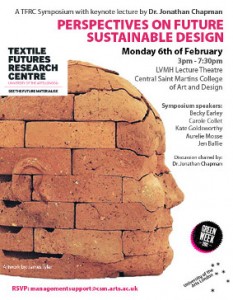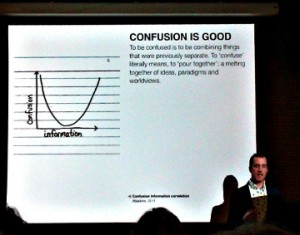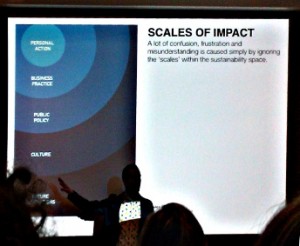
“How can we be the change we, as a group, want to see in the world?”(*)
That the whole sustainability discussion offers few straight answers, but instead plenty of reasons for confusion, doubts and grey areas, comes probably for no one as a surprise. In fact, part of the fascination of it all is indeed precisely not only the scale of the problem, but the fact there is no such thing as a single clear-cut answer. There are plenty of paradoxes, uncertainties, and probabilities of various degrees. But there is not a single one, if looked into in full detail, that will not raise a counter argument, or have some limitations to it.
And fashion & textiles certainly is not an exception. Rather: it is probably one of the best proves at hand for how little clear cut and black-and-white it all is as you progress in expertise.
The symposium 'Perspectives on Future Sustainable Design', which took place on February 6th 2012, and was organised by the Textile Future Research Centre at Central Saint Martin’s, London, successfully managed to raise the attendee’s attention to the limitations and uncertainties we are faced with. Equally however, the potential of future developments, well organised multi-lateral approaches, and multi-disciplinary efforts was made evident at every stage of the presentations.
The three principle talks of the day highlighted as a consequence different aspects of how ‘we’, ‘our life’ and ‘our sphere of influence’ can be improved in a way that, in the end, will multiply and grow into something larger.
Here after a summary of the principle concepts introduced by the three main speakers (Dr. Jonathan Chapman, Rebecca Early and Carole Collet) on the day:
- Sustainability is an opportunity, not a risk.
Even from an mere economic point of view, hardly any other area of the general ‘business’ consensus as changed as much as the discussions around sustainability. We’re getting closer to a time when’being good’ is accepted as ‘being forward looking and innovative’. - The Triple Bottom Line has graduated into the Quadruple Bottom Line:
- People
- Environment (Planet)
- Economy (Profit)
- Culture
Any innovation must be evaluated, and deemed successful, along these for axes. - People are drawn to optimism and concrete solutions; they are not at all to pessimism, fuzziness, and scare mongering.
What this means for anyone who truly committed to create change in industries, or A Industry, is to find the problem, name it, and show how to do it better in a positive, ‘can do’ way.
This, by the way, is ‘just’ called innovation.
The challenge thereby is to present the best project. The best project, notably, in all relevant aspects – see -> Quadruple Bottom Line. - Paint the world in a brighter shade of green. But do it at every opportunity.
Innovation is a step wise improvement/refinement process. As such, rather than looking for the ultimate and best solution to improve a product, look for where a product (or process …) has the worst impact(s) in any of the 4 bottom line aspects.
Now invest your ingenuity in changing this so that the overall impact is significantly improved.
Make sure to repeat with anything you occupy yourself with, from product design to buying your next microwave for home. - Be, or become, aware of what you assume as a ‘given’ – and break through the ‘wall’.
Innovation doesn’t happen out of the blue. Real innovation usually happens because something we assumed as a given suddenly does not apply any more.
Example: Let’s assume you need to design a mobile phone – but without a screen, without a number key board, without the plastic of its casing.
What would be the result?
Sometimes it’s worth starting from scratch, purposely ignoring what you know, and what you have been instilled with in all those years of your life. - Scale matters. Specifically when the ‘sphere of influence’ is concerned.
The bigger you draw the circle of where you want to see results, the more difficult it gets. The more monstrous grows the task – and the less we end up doing.
Yet, only keeping to oneself is not the ideal either.
The solution is to focus on oneself, PLUS a small group of people who are not only like-minded, but to whom we have close enough links to ‘get things done’. Ask yourself in this context“How can we be the change weas a group, want to see in the world?”(*) - People need principles, and the tools and manuals to achieve them, so that they do not have to reinvent the wheel with every single of their decisions (or designs, innovations, developments).
An example targeting specifically fashion & textile designers, is the TED’s TEN project, which offers exactly that across the following 10 categories:
– Design to Minimise Waste (1)
– Design for Recycling / Upcycling (2)
– Design to Reduce Chemical Impacts (3)
– Design to Reduce Energy and Water Use (4)
– Design that Explores Clean/Better Technologies (5)
– Design that looks at Models from Nature & History (6)
– Design for Ethical Production(7)
– Design to Replace the Need to Consume (8)
– Design to Dematerialise and Develop Systems & Services (9)
– Design Activism (10) - The future holds technical possibilities we’re not generally aware of today, and which will trigger a fundamental shift in how we life, design, make and discard.
Example: If asked in 2000, would you have hoped in your wildest dreams that smart phones would be common place in 2012 already?
The same holds true for many technologies currently, if at all, worked on in research labs around the world. Maybe, in 20, 30, 40 years’ time, we will be able to have biodegradable fabrics of all kinds effectively grown by bacteria; software with which each and everyone can design her own clothes, and 3D printers that are actually able to make our designs.
Futuristic, granted, but not impossible. Whether any prediction as this is accurate, or rather not, that again, is a completely different discussion.



(*) Adaptation of Mahatma Ghandi’s quote by Dr. Jonathan Chapman, University of Brighton.

